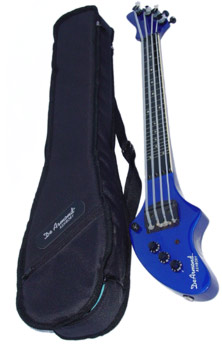
Spent a really nice evening with friends last night and was introduced to two instruments that I am longing to add to my musical arsenal- the Ashbory electric bass and the Butterfly harp (thai khim).
The Ashbory is a silicone rubber stringed electric bass instrument. It has a sound more resembling an acoustic upright string bass than anything else, but is in a form a little more reminiscent of an electric bass guitar. It has a short scale which provides the player with exciting new opportunities in playing while at the same time allowing the instrument to be small enough to put in the overhead compartment in an airliner.
What will you do with an Ashbory bass? Depends on who you are. Some people use them primarily for recording since they have a thick, warm tone that records well. Some gig with their Ashbory, appreciating the tone as well as the light weight and mobility advantages of a smaller instrument.
The Ashbory is especially popular as an accent, or second instrument, not unlike how some bass players will switch between a fretted 4 string bass and an 8 string fretted bass. It makes a great second instrument, familiar enough to pick up fairly quickly, yet different enough to allow for more tonal variation, and even allow for new elements to emerge in one's playing. It is also the best compact bass instrument for travel, small enough to carry-on, light enough to not be an inconvenience to carry, yet with a large sound which defies it's small size.
The Ashbory isn't for everyone. For some it is too much of a departure from their old standby bass. There isn't a good funk/slap electric bass guitar sound to be found anywhere. But, for the more adventuresome player who loves to play and likes to use an instrument as a extension of themself, the Ashbory is an excellent and powerful tool.

The khim was introduced to Thailand over a century ago by Chinese merchants, who referred to it as a yang ch'in. Thai artisans have adapted the instrument – similar to a dulcimer – in order to accommodate regional forms of music. Jeerasak Iverse crafts the body and its sleek cover from local jackfruit wood, as the undulating design complements its sonorous potential. Lacquered to brilliant perfection, the piece features 42 quality bronze strings, achieving a surprisingly delicate tone. Includes bamboo sticks with rubber tips and a convenient tuning key.









1 comment:
Beautiful blog Jenelle
Post a Comment